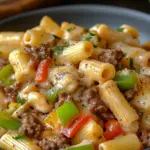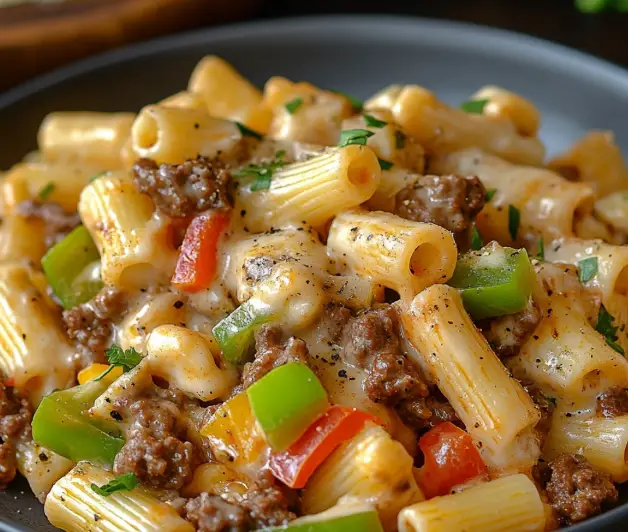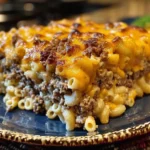If you’re a fan of the classic Philly cheesesteak and love hearty pasta dishes, Philly Cheesesteak Pasta is the perfect fusion for your next meal. This dish takes the iconic flavors of the famous Philly cheesesteak sandwich—juicy beef, sautéed bell peppers, and onions—while incorporating them into a creamy, cheesy pasta base. Whether you’re looking for a comforting weeknight dinner or something impressive for guests, this recipe provides an easy and delicious solution.
Philly Cheesesteak Pasta combines the richness of cream cheese with the satisfying texture of al dente pasta, making it a versatile option for a wide range of tastes. For those who enjoy creamy sauces and savory meats, this recipe will quickly become a family favorite. Not to mention, it’s a simple way to recreate the flavors of the cheesesteak sandwich without needing to head to a sandwich shop.
Learn more about the origin of this delicious fusion and try other exciting cream cheese recipes here on Pinterest.
History of Philly Cheesesteak :
The original Philly cheesesteak dates back to the 1930s in Philadelphia, where Pat Olivieri, a hot dog vendor, famously created the sandwich by accident. Over time, the sandwich evolved with the addition of various toppings like provolone cheese, which has become a staple in today’s cheesesteak recipes. This Philly Cheesesteak Pasta is an evolution of that beloved sandwich, blending traditional flavors with modern convenience.
Ingredients Breakdown and Substitutions :
Key Ingredients :
This Philly Cheesesteak Pasta relies on several key ingredients to achieve its signature flavor and texture. Each component brings something unique to the dish, ensuring that the final result is both delicious and satisfying.
- Ground Beef or Steak Strips :
The foundation of this dish is the meat, typically either ground beef or thinly sliced steak strips. Ground beef offers a quicker, more convenient option, while steak strips give a more authentic Philly cheesesteak feel. Whichever you choose, ensure it’s cooked to perfection—juicy but not dry. For those looking to make a healthier alternative, you can substitute ground beef with leaner options like ground turkey or chicken. For a vegetarian twist, consider using mushrooms or a plant-based meat alternative. Read more about the history of ground beef and its uses. - Bell Pepper and Onion :
The combination of green bell pepper and onion is essential to recreate the true taste of a Philly cheesesteak. These vegetables bring a subtle sweetness that complements the savory beef. Sautéing them until soft ensures they blend seamlessly with the creamy sauce while retaining a slight crunch. Discover more about bell peppers and their versatility in cooking. - Cream Cheese and Provolone Cheese :
To achieve the creamy consistency that makes this pasta so indulgent, cream cheese plays a vital role. Its richness helps coat the pasta and meat, ensuring every bite is flavorful. Provolone, traditionally used in Philly cheesesteaks, adds that perfect, slightly sharp finish. If you don’t have provolone on hand, other cheeses like mozzarella or cheddar can be substituted, though they may alter the overall flavor. For more about the deliciousness of provolone cheese, click here.
Pasta Selection :
When making Philly Cheesesteak Pasta, the choice of pasta is important. Shapes like penne or rigatoni are ideal because their ridges hold onto the creamy sauce, ensuring every bite is packed with flavor. These tubular shapes are sturdy enough to support the meaty, cheesy sauce without becoming too soft. While these are the recommended options, you could also use fusilli, ziti, or even farfalle for a different texture. No matter the pasta you choose, cooking it al dente is key to prevent it from becoming mushy when mixed with the sauce. Learn more about the art of cooking pasta.
Additional Ingredients :
- Garlic: The minced garlic adds depth to the sauce, bringing in a robust flavor that enhances the other ingredients.
- Beef Broth: This not only adds moisture to the sauce but also deepens the umami taste, complementing the beef and cheese.
- Salt and Pepper: Essential for seasoning the meat and vegetables, ensuring the dish doesn’t taste bland.
- Olive Oil: Used for sautéing the vegetables, olive oil adds a subtle richness and helps to caramelize the onions and peppers. Discover more about the benefits of olive oil in cooking.
Step-by-Step Cooking Instructions :
Step 1: Cooking the Pasta
Start by boiling a large pot of salted water for the pasta. Whether you’re using penne or rigatoni, cook it al dente, as this will allow the pasta to hold up better when combined with the sauce. The ridged pasta shapes are perfect for catching the creamy sauce and cheese. Follow the package instructions for cooking times, but keep a close eye to prevent overcooking. Once done, drain the pasta and set it aside. If you’re not mixing it immediately, you can toss the pasta lightly in olive oil to prevent sticking.
Step 2: Sautéing the Vegetables
Heat olive oil in a large skillet over medium heat. Add the diced green bell pepper and onion, sautéing until they become soft and slightly caramelized. This process takes about 5-7 minutes. Next, add the minced garlic and continue cooking for another minute, ensuring it doesn’t burn. The garlic will release its aroma, blending well with the sweetness of the onions and peppers. By sautéing these vegetables properly, you create a base that complements the savory meat and rich sauce. Be mindful of the heat to avoid overcooking or burning.
Step 3: Cooking the Meat
Once the vegetables are softened, push them to the side of the skillet. Add the ground beef or steak strips to the center, ensuring the skillet is hot enough to get a nice sear. Cook the meat until it is browned and fully cooked through—this should take about 7-10 minutes. For a traditional Philly cheesesteak flavor, season the meat with salt and pepper as it cooks. If using steak strips, avoid overcooking to maintain tenderness. For more cooking tips, explore steak cooking tips on Pinterest.
Step 4: Making the Creamy Sauce
After the meat is fully cooked, stir in the cream cheese and beef broth. The cream cheese will start to melt and combine with the broth, forming a luscious sauce. Stir continuously to ensure the sauce has a smooth texture without lumps. If the sauce becomes too thick, add a little extra broth until you reach the desired consistency. The mixture of cream cheese and beef broth will create a flavorful base that coats both the meat and vegetables, making the entire dish irresistibly creamy. Adjust the seasoning as needed.
Step 5: Combining Everything Together
Now that the sauce is ready, stir in the cooked pasta, making sure it is well-coated with the creamy mixture. Gently fold in the sautéed vegetables and beef to ensure everything is evenly distributed. The ridged pasta will help trap the sauce, meat, and veggies, ensuring each bite is packed with flavor. If the sauce seems too thick at this point, you can add a bit more broth or even a splash of pasta water to loosen it up. Ensure the entire dish is well-mixed and heated through.
Step 6: Topping with Cheese and Broiling
Once the pasta is thoroughly mixed with the meat and sauce, transfer it to an oven-safe dish. Sprinkle a generous amount of shredded provolone cheese over the top. Place the dish under the broiler for a few minutes until the cheese melts and becomes bubbly. Watch it closely to avoid burning, as broilers can vary in intensity. The melted provolone cheese adds a final layer of gooey, rich flavor that ties the dish together. Once it’s perfectly browned and bubbly, your Philly Cheesesteak Pasta is ready to be served.
Tips, Tricks, and Variations :
Tips for Perfect Philly Cheesesteak Pasta :
Creating the perfect Philly Cheesesteak Pasta is all about balancing flavor, texture, and timing. Here are some key tips to ensure your dish turns out amazing every time:
- Season as You Go: Properly seasoning each layer—vegetables, meat, and sauce—ensures that your final dish is bursting with flavor.
- Control the Sauce Consistency: If your sauce becomes too thick, don’t be afraid to add more beef broth or a splash of pasta water. This helps maintain a smooth and creamy texture.
- Use Fresh Ingredients: Fresh bell peppers, onions, and garlic will always deliver better flavor than frozen or pre-chopped alternatives.
- Cheese Melting Tip: For that perfect cheesy topping, use freshly shredded provolone instead of pre-shredded cheese, as it melts more smoothly without becoming greasy.
For more tips on achieving a delicious pasta dish, explore easy pasta dishes on Pinterest.
Common Mistakes to Avoid :
While this dish is relatively simple to prepare, there are a few common pitfalls you should avoid:
- Overcooking the Pasta: Remember to cook your pasta al dente; overcooked pasta can become mushy when mixed with the sauce.
- Burning the Vegetables or Garlic: Sauté the bell peppers and onions over medium heat to soften them without burning. Garlic should be added last since it burns quickly.
- Too Thick or Too Runny Sauce: If your sauce becomes too thick, add a bit more broth. Conversely, if it’s too runny, allow it to cook down longer to thicken.
Recipe Variations :
This recipe is highly adaptable, allowing you to tailor it to your dietary needs or flavor preferences. Here are some popular variations:
- Vegetarian Version: Replace the ground beef or steak strips with hearty vegetables like mushrooms or plant-based protein alternatives. Mushrooms work particularly well because they offer a meaty texture and deep umami flavor.
- Healthier Version: Swap out regular pasta for whole-wheat pasta to add fiber and nutrients. You can also use low-fat cheeses and reduced-fat cream cheese to make the dish lighter.
- Spicy Version: If you enjoy a little heat, add red pepper flakes or a splash of your favorite hot sauce when sautéing the vegetables, or mix into the sauce for a kick of spice.
Serving Suggestions and Pairings :
How to Serve Philly Cheesesteak Pasta :
To truly enjoy your Philly Cheesesteak Pasta, presentation and serving are key. Once your dish is hot and the cheese is perfectly melted, garnish with a sprinkle of fresh parsley for a pop of color and a slight herbal note. Serve it straight from the oven while the cheese is still bubbling for the best texture and flavor. This dish is hearty and filling on its own, but it can also be served family-style in a large dish to allow everyone to dig in. For a complete meal, consider pairing it with some complementary sides.
Side Dishes That Pair Well :
To balance out the richness of the Philly Cheesesteak Pasta, here are a few side dishes that work wonderfully:
- Garlic Bread: A slice of crispy, buttery garlic bread or a toasted baguette is a classic accompaniment to creamy pasta dishes. The crunchy texture and savory flavor offer a delightful contrast.
- Light Salad: A fresh, simple salad can help cut through the richness of the pasta. Try a Caesar salad, arugula salad, or a crunchy coleslaw for something light and refreshing.
- Beverages: When it comes to drinks, a glass of red wine, such as Cabernet Sauvignon, complements the hearty beef and cheese in the pasta. If you prefer something non-alcoholic, consider pairing it with a chilled glass of lemonade or an iced tea for a refreshing contrast to the creamy pasta.
- Can I make this dish ahead of time?
Yes, Philly Cheesesteak Pasta can be made ahead of time. Simply prepare the entire dish, but hold off on adding the provolone cheese and broiling. Store the cooked pasta in an airtight container in the refrigerator for up to two days. When ready to serve, sprinkle the cheese on top and broil it just before serving. This ensures the pasta remains creamy and the cheese is fresh and bubbly. - What can I substitute for cream cheese?
If you’re out of cream cheese, there are several alternatives. You can use sour cream or Greek yogurt for a tangy twist. Ricotta cheese also works well if you prefer a lighter, fluffier texture. These substitutes will slightly change the flavor profile but still deliver a creamy sauce. - How do I keep the cheese from becoming greasy?
To prevent the cheese from becoming greasy, use freshly shredded provolone cheese instead of pre-shredded. Pre-packaged cheeses often contain anti-caking agents that can make the cheese melt unevenly. Broiling at a moderate temperature also helps avoid an overly greasy top. - Can I use chicken instead of beef?
Absolutely! You can easily swap the beef for chicken breast or thighs. Just be sure to cook the chicken thoroughly before adding it to the sauce. The dish will maintain its savory, creamy flavor with a lighter protein option.

Philly Cheesesteak Pasta
- Author: Easy Recipes
Ingredients
1 lb ground beef or steak strips
1 green bell pepper, diced
1 onion, diced
2 cloves garlic, minced
8 oz cream cheese, softened
1 cup shredded provolone cheese
12 oz pasta (penne or rigatoni recommended)
1 cup beef broth
Salt and pepper to taste
1 tbsp olive oil
Instructions
Cook Pasta: Boil pasta until al dente. Drain and set aside.




